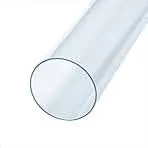Дек . 07, 2024 02:46 Back to list
cpvc panel
Understanding CPVC Panels Properties, Applications, and Benefits
Chlorinated Polyvinyl Chloride (CPVC) panels are a type of polymer material that has gained immense popularity in various industries due to their unique properties and versatility. CPVC, a derivative of polyvinyl chloride (PVC), is created through the chlorination process, which enhances its thermal stability and chemical resistance. This article aims to delve into the characteristics, applications, and benefits of CPVC panels, providing insights into why they are becoming a preferred choice in many sectors.
Properties of CPVC Panels
CPVC panels are known for their exceptional durability and resilience. One of the primary advantages of CPVC is its superior resistance to temperature changes, making it suitable for environments that experience high temperatures. While standard PVC can withstand temperatures up to 60°C (140°F), CPVC can easily handle temperatures reaching 100°C (212°F). This thermal property is particularly beneficial in industrial applications where heat exposure is a concern.
In addition to heat resistance, CPVC panels exhibit excellent chemical resistance. They are capable of withstanding a wide range of corrosive substances, including acids and bases. This characteristic makes CPVC an ideal choice for applications in the chemical processing and manufacturing industries, where protective barriers against aggressive chemicals are required.
Moreover, CPVC panels boast outstanding fire resistance. They are classified as self-extinguishing materials, meaning they do not support combustion. When exposed to flames, CPVC panels will typically char rather than burn, reducing the risk of fire hazards in various settings.
Applications of CPVC Panels
Given their robust characteristics, CPVC panels find applications across multiple fields. In construction, they are commonly used for both interior and exterior applications. Their lightweight nature allows for easy handling and installation. CPVC panels are often used in the creation of partitions, wall cladding, and roofing systems, providing excellent insulation and aesthetic appeal.
cpvc panel

In the plumbing industry, CPVC is widely recognized for its use in piping systems. CPVC pipes are often favored over traditional materials because of their impressive temperature and pressure ratings. They are ideal for hot and cold water distribution, as well as for transporting corrosive liquids.
Moreover, in the healthcare sector, CPVC panels are increasingly used in the production of sanitary and hygienic environments. Hospitals and laboratories require materials that can be easily cleaned and sterilized, and the non-porous surface of CPVC meets these criteria, ensuring hygiene and safety.
Benefits of Using CPVC Panels
The advantages of using CPVC panels extend beyond their properties and applications. One significant benefit is their cost-effectiveness. Compared to other materials, CPVC panels provide a cost-efficient solution without compromising quality. The reduced maintenance required due to their durability contributes further to long-term savings.
Additionally, CPVC panels are environmentally friendly. They can be manufactured with recycled materials and are fully recyclable at the end of their life cycle. By choosing CPVC, businesses can contribute to sustainability efforts and reduce their overall environmental impact.
Another compelling reason for using CPVC panels is their energy efficiency. Thanks to their insulation properties, CPVC helps in minimizing energy consumption in buildings. This not only reduces operational costs but also contributes towards achieving energy efficiency standards.
Conclusion
In conclusion, CPVC panels are an exceptional choice for a range of applications across various industries due to their superior properties, versatility, and cost-effectiveness. From construction and plumbing to healthcare, the advantages they provide make them a valuable option for businesses looking to enhance their operational efficiency and sustainability. As industries continue to seek innovative materials that can withstand the rigors of modern demands, CPVC panels will undoubtedly play a significant role in shaping the future of manufacturing and construction.
-
Premium PVC Transparent Pipe: Durable & Clear Solutions
NewsJul.31,2025
-
High-Quality UPVC Electrical Pipe for Safe Wiring Solutions
NewsJul.30,2025
-
Premium PVC Pipe Fitting Supplier – Durable & Leak-Proof Solutions
NewsJul.30,2025
-
High-Gloss PVC Rigid Sheet for Durable & Smooth Surfaces | Wholesale Supply
NewsJul.29,2025
-
High Quality PVC Soft Sheet for Flexible and Durable Applications
NewsJul.29,2025
-
High-Quality PPR Pipe for Plumbing Systems - Durable & Leak-Proof
NewsJul.29,2025

